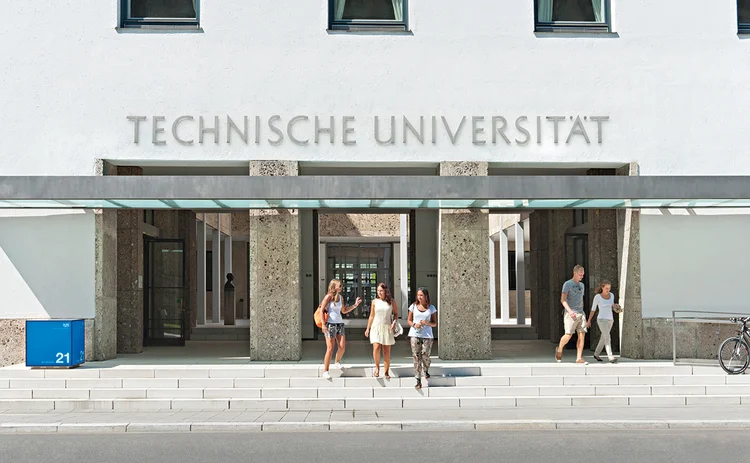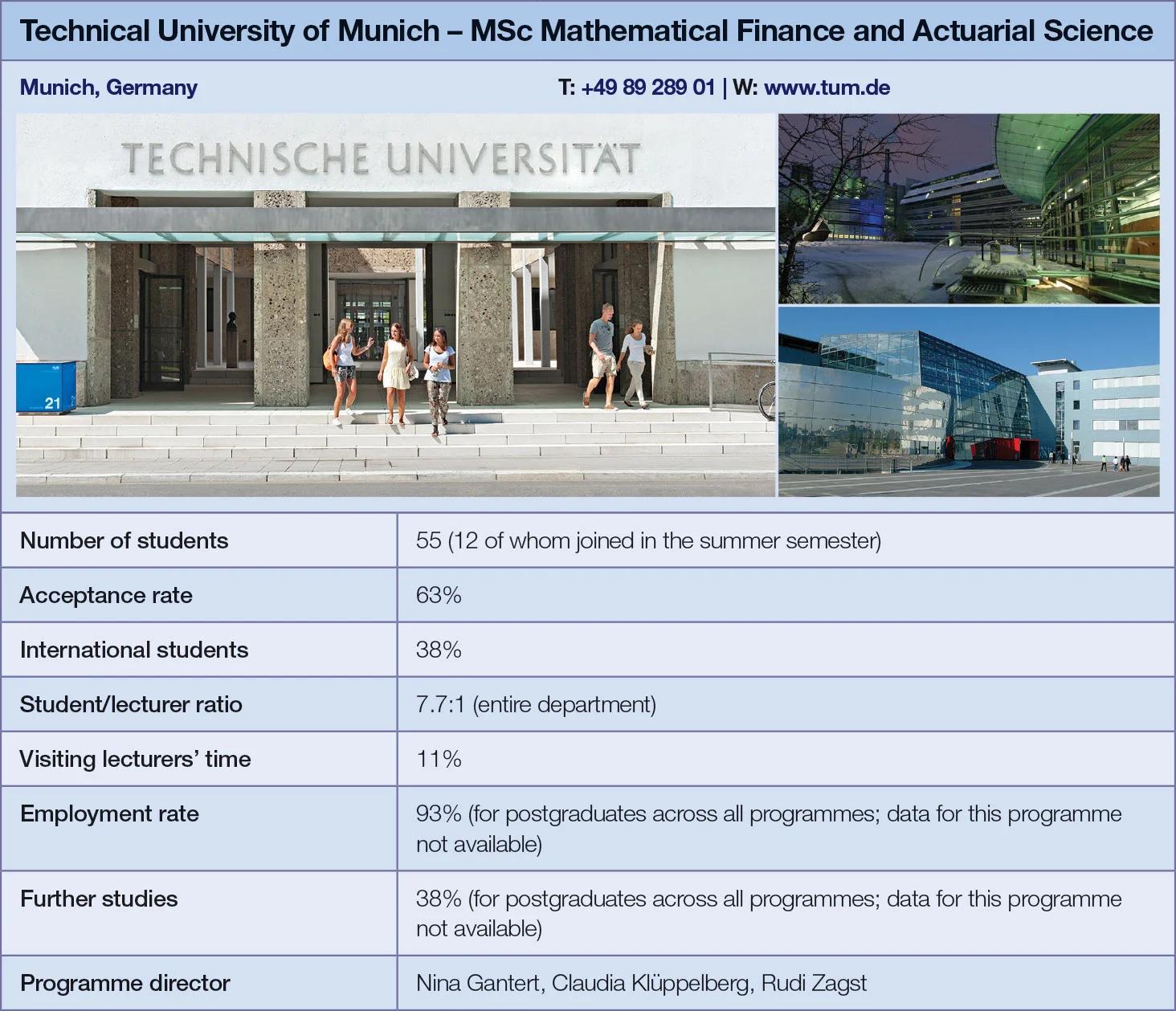
Quant Guide 2017: Technical University of Munich
Munich, Germany

MSc Mathematical Finance and Actuarial Science | metrics table at end of article
The Technical University of Munich (TUM) offers a four-semester master’s in mathematical finance and actuarial science aimed primarily at mathematicians. Applicants need an undergraduate degree or equivalent in mathematics, operational research or a similar subject. The programme is practically oriented and students have the option to specialise in either mathematical finance or actuarial science.
The specialisations offer students advanced courses in relevant topics. Three courses highlighted by Aleksey Min, academic counsellor on the programme, include investment strategies, fixed-income markets, and actuarial risk theory.
“Our students have a deep mathematical background due to the broad spectrum of courses in stochastics, statistics, numerics, operations research, and computer sciences we can provide,” says Min. The financial mathematics option also has a course on quantitative risk management.
Demand for risk management personnel has increased, says Min, and graduates of the programme have benefited from this shift. “Companies want more mathematicians because they would like to build their own models, validate them, backtest them and so on,” says Rudi Zagst, co-chairman of the programme. “Risk management will not work without firm knowledge of quantitative methods and their practical application.” Graduates of the programme will typically have jobs related to risk management, portfolio management or insurance.

In addition to a specialisation and the compulsory stochastic analysis course, students choose from electives in stochastics, mathematics and management. Stochastics courses include modules in statistics, data analysis and machine learning while mathematics courses include modules in numerical analysis, optimisation and other purer mathematical topics. Management courses look at, for example, derivatives, risk management and energy markets.
The programme started in 2007; students typically stay for four semesters. Applicants have a choice between beginning their studies in the winter or summer semester. Lectures were delivered only in German until 2014 but it is now possible to complete the programme in English. This has attracted international applicants to the programme. Min says there is no limit on the number of students who can be admitted.
A four-week internship is a mandatory part of the course, during which students are required to apply the mathematics they have learned in their courses. At the end of the internship students will give a presentation of their industry experience outlining which methods they used.
“Most students do more than one internship,” says Elisabeth Ailer, graduate. She believes it’s important to do at least two internships in order to get a good understanding of how the industry works.
The university also hosts the Fit for TUMorrow advanced training programme, which organises a number of industry-related events. It offers students the option to discuss current trends in the industry and become familiar with professional trading tools. Another project, the Risk Factory, is an opportunity to experience being a trader through real-time simulations of trading environments using real market data. There is, however, limited space in the Risk Factory. TUM also organises Meet My Company where every week a different company representative will visit and present the work their company does.
The university’s KPMG Center of Excellence in Risk Management invites speakers to its conference and various workshops. Past speakers have included Christian Bluhm, currently chief risk officer at UBS, and John Hull, a professor at the University of Toronto. Conferences are hosted every two years with 2017’s conference focusing on innovations on insurance, risk and asset management. Previous workshops have included ‘Frontiers in risk management’ and ‘Malliavin calculus and applications to finance’.
Ailer works on asset allocation at Risklab, part of Allianz Global Investors. She graduated in 2016. An attractive part of the programme for Ailer was its balance between theoretical and applied topics. “I felt the course knew where the industry was going,” says Ailer, “but it also had a strong mathematical background.”
The reputation of the university helped with job interviews, she says, as employers had a good idea of what the students had learned. “It was universally known that TUM had a good course and the professor was well known in the industry.”

Click here for links to the other universities and an explanation of how to read the metrics tables
Only users who have a paid subscription or are part of a corporate subscription are able to print or copy content.
To access these options, along with all other subscription benefits, please contact info@risk.net or view our subscription options here: http://subscriptions.risk.net/subscribe
You are currently unable to print this content. Please contact info@risk.net to find out more.
You are currently unable to copy this content. Please contact info@risk.net to find out more.
Copyright Infopro Digital Limited. All rights reserved.
As outlined in our terms and conditions, https://www.infopro-digital.com/terms-and-conditions/subscriptions/ (point 2.4), printing is limited to a single copy.
If you would like to purchase additional rights please email info@risk.net
Copyright Infopro Digital Limited. All rights reserved.
You may share this content using our article tools. As outlined in our terms and conditions, https://www.infopro-digital.com/terms-and-conditions/subscriptions/ (clause 2.4), an Authorised User may only make one copy of the materials for their own personal use. You must also comply with the restrictions in clause 2.5.
If you would like to purchase additional rights please email info@risk.net
More on Quantitative finance
Quant Finance Master’s Guide 2026
Risk.net’s guide to the world’s leading quant master’s programmes, with the top 25 schools ranked
Baruch, Princeton cement duopoly in 2026 Quant Master’s Guide
Columbia jumps to third place, ETH-UZH tops European rivals
Quant Finance Master’s Guide 2025
Risk.net’s guide to the world’s leading quant master’s programmes, with the top 25 schools ranked
Baruch maintains top spot in 2025 Quant Master’s Guide
Sorbonne reclaims top spot among European schools, even as US salaries decouple
Quant Finance Master’s Guide 2023
Risk.net’s guide to the world’s leading quant master’s programmes, with the top 25 schools ranked
Baruch topples Princeton in Risk.net’s quant master’s rankings
US schools cement top five dominance as graduate salaries soar
Is it worth doing a quant master’s degree?
UBS’s Gordon Lee – veteran quant and grad student supervisor – asks the hard question
Starting salaries jump for top quant grads
Quant Guide 2022: Goldman’s move to pay postgrads more is pushing up incomes, says programme director







